‘We’ll be living with these’: The renewable-energy blitz dividing regional towns
Despite having billions behind it and broad public support, Australia’s renewable energy rollout is facing headwinds in the very communities it needs on board. For the transition to succeed, they need a bigger stake in it.
By James Button
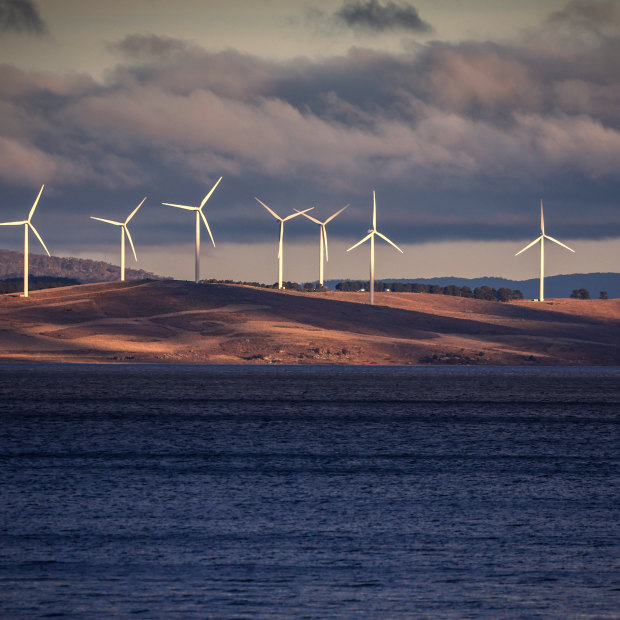
Hundreds more wind and solar farms are needed for the energy transition. “We will be living with these giant structures for the rest of our lives,” says a resident living near a proposed wind farm. Credit: Getty
Alison McLean was worried. Consultants from big companies that people in Hay had never heard of were coming into the western Riverina, telling farmers they were part of something called a REZ – a renewable energy zone – and making cash offers to some to host wind and solar farms and batteries on their land. Although the NSW government had announced the South-West REZ in 2022, no official had come to Hay to discuss it. The grapevine was going crazy.
As economic development manager at Hay Shire Council, McLean knew of the government’s plans. Her council was in one of five declared NSW renewable energy zones where projects would be concentrated. Millions of dollars in developer funds for the local community might follow. For her region of marginal land, with a proud farming history but also a shrinking population, McLean saw this as a big opportunity, maybe the biggest since Hay was founded on the Murrumbidgee River more than 150 years ago.
But how could a town of 3000 people have any say over the juggernaut coming down the highway? McLean had seen this situation spin out of control in towns like Walcha, in the state’s New England region. Neighbours fighting, local councillors split, facts and fictions flying – all over a wind farm. This could all happen in Hay, too. There had to be a plan, and not just a council plan. So the council invited 12 well-known locals to a meeting to discuss how the whole community might respond to the REZ.
Phil Wilson, a 50-year-old mechanic, was one of them. Wilson also does roadworks, is a flight instructor, and plays Aussie rules for the Hay Lions. He’s embedded in the life of the town but in one respect, he was an odd choice for a plan to deal with climate change. He accepts it is happening, but not that humans are the main cause of it. He thinks wind farms, which he flies over, are “a scourge on the landscape”. As for a facility going up near Hay that will convert animal waste into energy: “They’re building a shed to capture cows’ farts. Mate, what a joke.”
Still, Wilson supports any development that brings jobs and investment to Hay. When McLean invited him to the meeting, he came. “Money drives everything, and climate is no exception,” he says, sitting in a Hay cafe. “I always say, ‘Follow the money.’ ”
McLean and Wilson are an unusual pair, and Hay is an unlikely place, to be prominent in a plan to confront one of humanity’s greatest perils. But in the past few years, the frontier of the climate battle has shifted. Even this most planetary of issues must submit to the old saying: all politics are local.
After more than a century as Australia’s main energy source, coal is on the way out. It is unlikely to be burnt for power after 2038. State and federal governments have identified renewable energy as the main power source to meet their legislated goals of net zero emissions by 2050 and, more urgently, to maintain a reliable electricity grid as ageing coal-fired power stations exit the system. Forty-three potential renewable energy zones – six of them offshore – have been selected across the five southern and eastern states to host many hundreds of new wind and solar farms, hydro projects and batteries. About 10,000 kilometres of new transmission lines will carry power back to the cities. In NSW and Victoria, much of the generating capacity will be placed on the plains and rolling hills west of the Great Dividing Range.
Bureaucrats and corporate chiefs call this shift “the energy transition”. It’s a term of professional optimism and wild understatement, yet it’s underway. In just the past seven years, the share of electricity in Australia supplied by renewable energy has leapt from 17 per cent to 39 per cent. Solar panels sit on the roofs of one in three Australian homes.
The planned infrastructure build is bigger than the postwar Snowy Mountains Scheme. It has billions of corporate dollars behind it, and has been supported by state governments from all sides of politics. Most Australians favour renewable energy, according to opinion polls. But despite these strong tailwinds, the rollout is struggling. Many projects are meeting opposition. Many have been stalled for years in state planning schemes, especially in NSW, where the Clean Energy Investor Group calculated that wind farms took an average of 3488 days – nearly 10 years – to be approved.
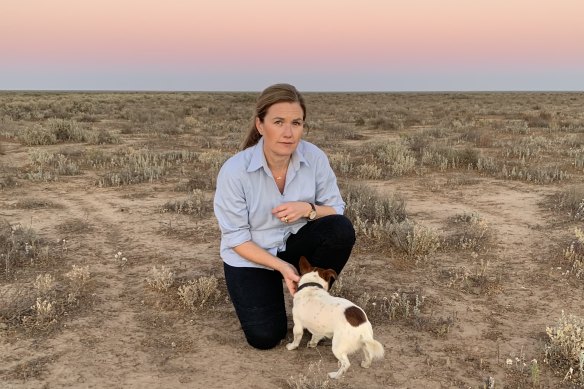
Alison McLean and her dog Gary in a paddock on her drought-stricken sheep farm north of Hay. “If we can see the turbines, we want to feel it in our hip pocket,” she says.
Now energy is shaping up as a major federal election issue after the Coalition declared its commitment to downgrading renewables in favour of starting an Australian nuclear industry from scratch. The CSIRO says such a move would take at least 15 years – former chief scientist Alan Finkel says 20 – making coal replacement and Australia’s emissions targets impossible to achieve. But governments overseeing the transition are also under great pressure: if the power goes out, so do they. In betting on nuclear, the Coalition leadership is calculating not only that renewables can’t supply enough reliable power, but also that a backlash in the bush will slow down so many projects that nuclear, and probably more gas, will be essential. The life of coal plants might even have to be extended.
Many arguments mounted against renewables in planning cases are environmental, including loss of visual amenity, damage to bush and farmland, and risks to native species. There is also resentment that the bush is being asked to bear the burden of the cities’ need for power. “These people come and go. They fly in and fly out,” says Dr Melanie Oppenheimer, a resident living near the proposed Walcha wind farm. “This is our home. We will be living with these giant structures for the rest of our lives.”
But the transition has strong support in the regions, too. Private companies pay farmers more than $40,000 a year – drought-proof income over the 25-odd-year life span – for every wind turbine they host, and about $1500 per hectare a year for solar farms. Compensation for hosting transmission lines is less, although NSW now offers landholders $200,000 in total, paid over 20 years, for each kilometre of line.
Developers also provide affected areas with “community benefit funds”. For a very large project, these can be $1 million a year for 30 years, and might be used by councils or community organisations to boost the economies of small, often struggling towns. In this finely balanced argument, the great majority of locals are in the middle: uninvolved, uncertain, open to persuasion. And that’s where people close to the rollout are sounding a warning.
In his 2023 community engagement review for the federal government, Australian Energy Infrastructure Commissioner Andrew Dyer (now retired) found widespread dissatisfaction with the way renewable energy developers, and especially transmission line operators working for governments, had made their case to regional Australia. Without the support and participation of these communities, Dyer wrote, “the transition cannot succeed.”
Over the past 18 months, human geographer Dr Fiona McKenzie and her team at the Orange Compass consultancy spoke with more than 200 landholders and community members affected by proposed renewables and transmission developments in NSW and Victoria, for studies commissioned by the federal government and companies. The farmers McKenzie met “were so excited to be listened to”, she says. “Some came with written speeches. Their hands were shaking as they read them. No one in government had spoken to them, let alone engaged with their concerns. One farmer had been called by a journalist asking how he felt about the transmission line going through his property. He asked: ‘What transmission line?’ ”
McKenzie says none of these landholders was against climate action. One said: “If someone had asked me, I would have told them which paddocks to put it on.” But “trust has been lost”, she wrote in a report for Lumea, the commercial arm of transmission operator Transgrid. In some communities, it would be best to start the consultation process all over again.
Their situation was like The Castle, the farmer told his father: compulsory acquisition, unjust terms.
In Victoria’s north-east, Helen Haines, independent federal member for Indi, sees growing anger about two big batteries and other planned energy projects in her electorate. She says her constituents had no prior knowledge they were in one of the renewable energy zones. Most got the news when a company leaflet announcing a proposed project was slipped under the door. “Consultation should have happened much earlier,” Haines says. “I hope it is not too late. Once people feel they have lost their autonomy and assemble into a tribe, they are hard to disassemble.”
Dyer, Haines and McKenzie are calling for a radical change of approach to keep the transition on track. What is that change? On a visit to Dubbo, centre of the first NSW renewable energy zone, Central-West Orana, and to Hay, centre of the South-West Zone, I found a conversation you would not hear in the inner cities or the teal seats. It’s tangible and local, not abstract and global. For many people, the need to act on climate change hardly figures in the story at all.
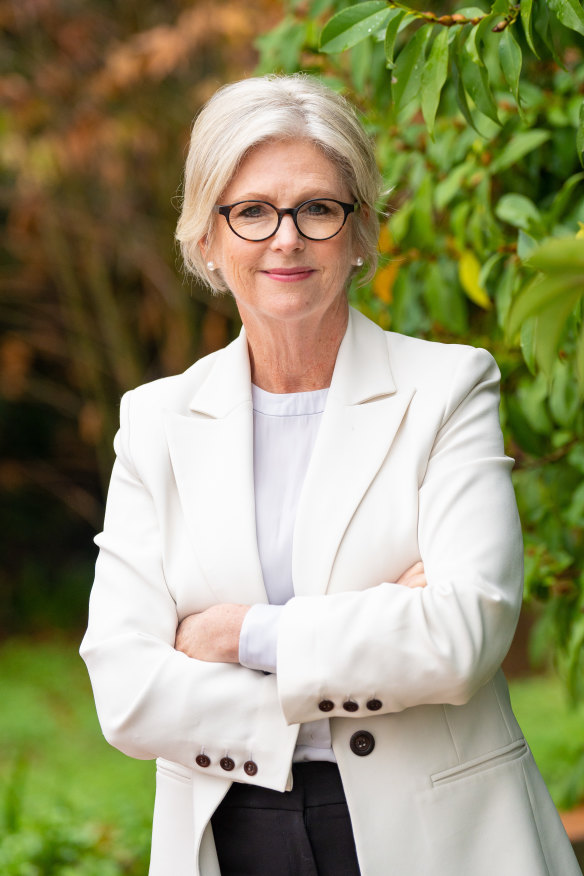
Indi MP Helen Haines: “Consultation should have happened much earlier. I hope it is not too late.”Credit: Simon Dallinger
The road to James Armstrong’s farm 150 kilometres east of Dubbo runs through lovely country, the morning mist lifting to reveal green hills. But when I say this to Armstrong, the 42-year-old sheep and cattle farmer grimaces: “It’ll be an industrial site soon.”
In November 2022, Armstrong was called by a consultant for EnergyCo, the statutory authority responsible for rolling out the NSW renewable energy zones. A transmission line was planned to run for eight kilometres down the middle of his property. It would run within 150 metres of his parents’ house. If he refused the offer, the easement would be compulsorily acquired. “It was a major shock,” says Armstrong. He spent the next 18 months fighting to get fair compensation. It cost him about half of his working week for a year, a lot of money and so much stress he had to see an online psychologist.
Armstrong’s father, Cam, had agreed nine years earlier to host the line (which stalled in planning). But those negotiations were thorough, unhurried and conducted with a private company: the farmer could always have said no. His son, James, had no such choice. And from day one, he felt short of information. EnergyCo staff spoke opaquely of tight deadlines they had to meet. But when the farmer asked crucial questions about how the construction period would affect his work – whether he could still crop in these paddocks, for example – they could not answer and seemed not to know. They would put nothing in writing.
When the compensation they offered was about one-thirtieth of Armstrong’s own figure, derived from consulting a range of specialists, the farmer decided to fight. Their situation was like The Castle, he told his father: compulsory acquisition, unjust terms.
Having built very little transmission for 40 years, Australia must install 10,000 kilometres of new or upgraded lines before 2050, half of them in the next decade. But transmission is a much tougher sell to landholders than wind or solar farms. Apart from lower compensation, governments can compulsorily acquire easements on properties marked out to host transmission lines. Some government-appointed contractors in NSW and Victoria, in a hurry to meet deadlines, have fired up landholders by threatening them with compulsory acquisition.
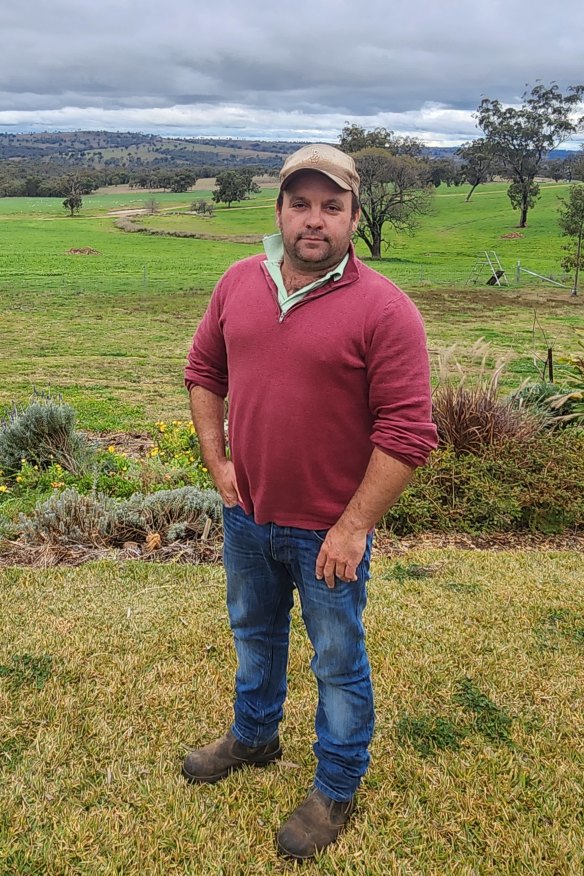
Farmer James Armstrong fought for 18 months for fair compensation for a transmission line through his land.
The line crossing Armstrong’s property is intended to come out of the large Liverpool Range Wind Farm, which has been 16 years in preparation, including a decade in the planning system. No dirt has yet been turned. In the planning process, objections to the wind farm vastly outnumbered supportive submissions, so staff of developer Tilt Renewables, which purchased the project in 2019, were keen that I talk to locals who backed it. One is Greg Piper, a sheep farmer. In 2017, the Sir Ivan bushfire devastated the country around Coolah, and burnt nearly Piper’s entire property; he lost 1500 head of stock. A three-year drought followed. Unsurprisingly, he was keen to host eight turbines of the Valley of the Winds project.
“I’m 69, the body starts to break down,” Piper says. “I look back at the financials over the last 20 to 30 years, four of them have been good. If it wasn’t for the wind farm, I’d tell Luke [his son, who works with him] to get out of the game.”
But Piper says his main motivation was tackling climate change. He thinks the Valley of the Winds and Liverpool Range wind farms will be “the best thing to happen to the area ever. Good locally, good for the world”. Piper wants funds provided by developers to be spent on schools and childcare to attract city professionals to Coolah, a pretty town that is losing people. A National Party member for 30 years, Piper quit a decade ago, in part because of the federal party’s attitude to renewable energy. “For years they’ve been crying out for investment in the bush and here it is in spades – and they don’t want it.”
Piper acknowledges the wind farms have “divided the community into haves and have-nots. People are going to get all this money for nothing. Others don’t like it. And the antis are very vocal.” They include his cousins, who live nearby. “We’re friendly enough, but on this we are so diametrically opposed.”
To try to close this divide, most wind farm developers pay landholders who are neighbours of a project. But some hurts can’t be healed by money. About 150 kilometres south of Coolah, in Cabonne Shire, Tim and Cassandra Sullivan have spent four years fighting the Kerrs Creek wind farm, proposed by British developer RES, that would abut their cattle property. Cassandra says they were asked to host turbines and said no, believing the project would damage their land value and the environment. A local group, Voice of Cabonne, was formed to oppose the project; it hosted a public meeting in February attended by more than 100 people and addressed by Nationals leader David Littleproud.
One landholder who said yes to the turbines is the Sullivans’ neighbour, Lachlan Sullivan – Tim’s brother. The siblings no longer speak. Cassandra declines to “air the family linen” and discuss the divide. But Lachlan told the Central Western Daily that his close relationship with Tim had changed. “I’ve had lots of sleepless nights over it and he was a great support to me when I had a very tough couple of years with my health.” But if his health problems recurred, “I’d love to have the financial security [of the turbines] for my wife and son.”
After I speak with Piper, Tilt Renewables staff drive me to a ridge where turbines will be placed. They show me the small size of their footprint – about 20 metres in diameter – and how livestock can graze around them.
But driving back to Dubbo as the late afternoon sun turns these hills golden, I wonder how many turbines and transmission lines would start to feel like too many. Of 40-odd projects planned within the Central-West Orana zone, about half – mainly wind and solar farms and substations – will be clustered in this 100-kilometre corridor of hills and valleys that runs north from Wellington to Gulgong, Dunedoo and Coolah. In national terms it’s a tiny area, but if enough people living in it are unhappy, delays could put the whole zone in trouble. That’s the risk of the REZ concept.
“This transition happens with us, not to us.”
Economic development manager at Hay Shire Council and sheep farmer, Alison McLean
City journalists sometimes characterise rural protesters as NIMBYs (not in my backyarders). Yet in the 1980s, Victoria’s State Electricity Commission tried to build an overhead power line from Brunswick to Richmond, in the heart of Melbourne. Protests were so fierce that a key part of the line had to go underground. It’s easy to mock NIMBYs until development comes to our own BY.
Whatever the legitimacy of protesters’ concerns, “if you want to put billions of dollars of turbines and transmission lines into a community, well, go listen,” Charles Rattray, CEO of Victorian-based offshore wind farm developer Star of the South, tells me. “It’s their beach or field or forest.”
Renewable energy is built on a paradox. To harness the power of wind, sun and water, all those good, natural things, we have to build a lot of stuff made of steel, glass, silicon and cement. The road to green goes through brown; to get clean energy, we must first get dirty.
Having cleared bush since 1788, we must clear more. The new-generation wind turbines can be 250 metres high, nearly twice the height of the Sydney Harbour Bridge. The fibreglass and carbon fibre blades can be 85 metres long and must be transported in what are known as “oversize overmass” trucks with pilot vehicles at both ends. When the construction phase of the NSW rollout cranks up, probably next year, 10 such convoys could leave the Port of Newcastle every night.
Solar farms can be installed quickly, but trucks that transport turbines require upgrades to highways, local roads and bush tracks twisting lazily up green hills. Sites for temporary camps, with dongas housing thousands of workers, must be found. Quarries must be dug to produce more than 1000 tonnes of gravel for every turbine base. Giant, spidery cranes will lift and stack tower pieces weighing up to 50 tonnes before clipping in the blades. Then the turbines are ready to turn in unison “like a field of sunflowers”, as one company website puts it.
Can the rollout grow the economy while protecting the environment? It’s a new version of an old argument, but with all the traditional roles scrambled. Addressing climate change, a defining progressive cause, is now big business, while Peter Dutton says his nuclear plants will be state-owned, whatever the cost.
The Opposition reaches for environmental arguments to attack renewables. Barnaby Joyce, momentarily channelling a 19th-century Romantic poet, has said regional Australia was being left “dispossessed” and “surrounded by an industrial landscape”. But many Liberal and National MPs, especially in state parliaments, think the transition will bring jobs and development to the bush.
Green groups are also divided. Is a wind farm, designed to help avert a planetary environmental disaster, worth the destruction of forest in Far North Queensland or the alleged risk to endangered species such as the brolga in western Victoria or the orange-bellied parrot in Tasmania?
A local epicentre of the transition in Central-West Orana is the small shire of Warrumbungle, based in Coonabarabran. Its mayor, Ambrose Doolan, a 59-year-old cattle farmer, embodies the complexities of public opinion in the zone. The three-year drought that ended in 2020 nearly destroyed his business. “I still have PTSD from the memory,” he says. He doesn’t link that event to global warming – “The climate’s always changing; you used to be able to walk to Tasmania” – but he believes in solar power. About 135 solar panels and six solar pumps help power Doolan’s farm.
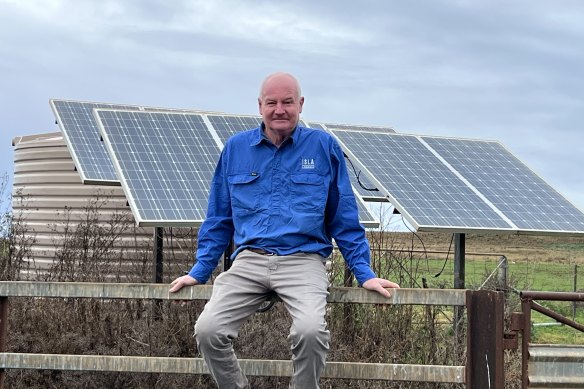
Warrumbungle shire mayor Ambrose Doolan says a majority of locals support the rollout – as long as it benefits them.Credit: Lisa Doolan
Warrumbungle has objected to several wind and solar farms, and Doolan says it will keep doing so until the state government promises to cover the cost of damage to roads and other local impacts from the rollout. “We should be whacking these things [turbines] up on the northern beaches of Sydney,” he likes to say.
But when I ask what his constituents think of the rollout, he replies: “I’d say more for than against. The really vocal ‘fors’ and the really vocal ‘againsts’ get all the attention, the quiet people are up the middle.” At a recent public meeting, Doolan was heckled by six or seven angry opponents of the zone. But a woman confided later she hoped the transition would bring her son, an electrical engineer, home to a renewable energy job. “You should have spoken up,” Doolan told her.
Doolan is a realist. The REZ has gone through state parliament with bipartisan support; it can’t be stopped, he says. His job is to ensure his shire benefits. He wants to use developer funds to upgrade the local sewerage plant. “It’s not a sexy thing but it smells.” He hopes industry will follow the rollout. “Let’s say, ‘Come and build a factory in Dunedoo and the power is free.’ Let’s set up the place for our kids and our kids’ kids.”
Across the Central-West Orana zone, the energy transition has unleashed a lot of hope. Dubbo Regional Council mayor Mathew Dickerson, a vocal supporter of the rollout, wants to use developer funds to build a centre in Wellington to train local workers for the renewable energy industry. Also in Dubbo, Indigenous entrepreneurs Joe Williams and Alex Frail have joined with Megan Jones of the Circular PV Alliance to create an organisation called Yurruga, the Wiradjuri word for sun, that wants to train young Indigenous people to repurpose used solar panels, among other potential energy jobs.
Across NSW, Aboriginal Land Council leaders hope the rollout will bring their people income and jobs to enable them to remain on country, writes historian Heidi Norman, lead author of a 2023 paper on Aboriginal people in NSW and the transition. Not one leader cited tackling climate change as a motive for embracing renewable energy.
Such hopes are more likely to be realised, and opposition to the transition reduced, if the regions have cheaper power, says Tony Wood of the Grattan Institute. “Every time people saw the turbines spinning, they’d think: ‘That’s coming off my power bill.’ ”
The Golden Plains wind farm in western Victoria offers up to $1600 of annual power bill credits to eligible customers living within three kilometres of the turbines. That clearly helps. In nearby Rokewood, Helena Kirby, the former mayor, tells me nearly the entire town supports the wind farm. But Wood says government and most developers have not tried this obvious incentive.
Instead, power in the bush is often more expensive and less reliable than in town. Residents of Ruffy, in Victoria’s Strathbogie Ranges, lost their power 11 times between Christmas and February, says Haines, their federal MP. “They think, ‘Wind turbines are going up on our hills, the power is going to the city and not one electron is coming to us.’ ”
On my last day in the Central-West Orana REZ, Jason Willoughby, chairman of Andrew Forrest’s Squadron Energy renewables company, gives me a tour of Crudine Ridge Wind Farm, south of Mudgee. For the first time, I stand under a wind turbine. Every Australian should do this. Gleaming white and 160 metres high at the blade tip, it has the feel of a recently landed starship, a messenger from the future. Its turning blade gives a gentle whoosh. Towering yet slender, the turbines run down the ridge into a vast bowl of fields, mountains and sky. I find them awe-inspiring. But I’m a tourist here.
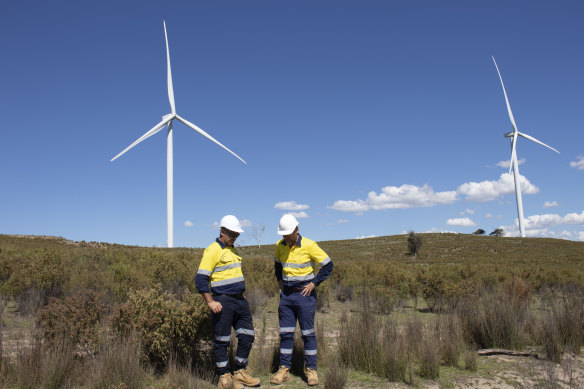
Staff from renewables firm Squadron Energy at Crudine Ridge Wind Farm, 45km south of Mudgee, NSW.Credit: May Lam
In January, the Mid-Western Regional Council, based in Mudgee, published a report charting the heavy pressures on roads, hospitals, schools and housing that would follow the arrival of up to 7000 mostly temporary workers in the Central-West Orana REZ. The report had influence: a senior state government official told me he kept it in the back of his car for reference. The state government had failed to prepare for these changes, council general manager Brad Cam told me in February. He described the REZ as “a train out of control and heading towards the cliff, because it’s been so poorly planned”.
By June, though, Cam was more optimistic that government was getting the message. He had just taken nine department heads, including Simon Draper, the Premier’s Department secretary, on a four-hour bus tour of country around Gulgong that will be transformed by the rollout. He showed them paddocks that will host almost five million solar panels. “I think they were overwhelmed,” he said. But the visitors made two things clear: they had to solve the pressures on services, and they would push on.
After a poor start to its consultation efforts in the region, EnergyCo is working hard to win over farmers such as James Armstrong. Ash Albury, a newly appointed senior executive who lives in Dubbo, came to see him and they held a long, good conversation over several hours, Armstrong says. Some transmission towers will be moved out of sight of his parents’ home. In a move that might improve community relations, Tilt Renewables will fund the extra cost of monopoles, which are less visually imposing than lattice towers, for properties affected by the Liverpool Range Wind Farm’s transmission line.
Armstrong has accepted a new compensation offer for the construction phase, which is still significantly lower than his own assessment. As one of 87 landholders (out of 90) who have now agreed to host the line, he is also entitled to compensation payments of $10,000 a year for each of the eight kilometres, a total of $1.6 million over 20 years.
Armstrong says he’d happily forgo the money if he could lose the line. Ultimately, though, what most upset him was the process. “I’m not stupid, I know transmission lines have to go somewhere,” he says. “But I felt they just rolled it out to meet timelines, without regard for the people they’re impacting. Slow it down. Engage the community.”
Can any government, especially one under the amount of pressure NSW is facing, oversee genuine community engagement while maintaining the pace of the transition? It seems an impossible dilemma, yet some people see a solution.
In April, I sat down with Andrew Dyer, who had just retired as Australian Energy Infrastructure Commissioner. While his 2023 review found that many renewables companies had failed to win support for their projects, Dyer offers a vital insight: it’s not all the companies’ fault. The design of the largely privatised energy market, especially in Victoria and NSW, deserves much of the blame.
Until privatisation got underway in the 1990s, electricity grids were publicly funded and run by engineers, who were conservative and planned infrastructure needs years in advance. That lost world has been replaced by what Dyer calls the “open-access prospecting model”. Any company can sign up landholders occupying the site of a potential energy project. Some plan to develop it, others merely to on-sell it to make a quick profit. Yet companies are constrained by the capacity of the transmission line into which they want to plug their project. Often the number of planned projects in an area far exceeds that capacity.
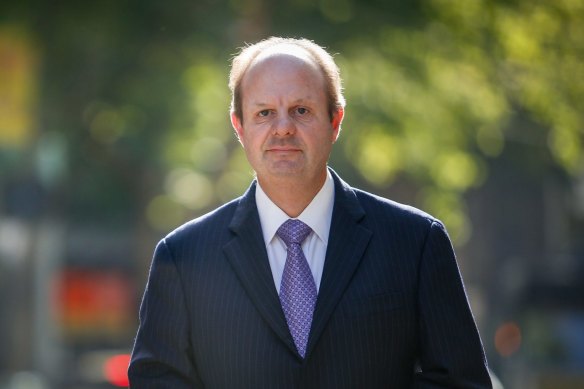
Andrew Dyer, who had just retired as Australian Energy Infrastructure Commissioner.Credit: Eddie Jim
Dyer cites the proposed VNI West transmission line, which runs from Bulgana to the Murray near Kerang in Victoria. That line might support four wind farms of about 120 turbines each. But when they hear about a new transmission line, “as many as 40 salesmen get out there, signing up landholders. Communities start to fear they will be inundated by these projects, yet only about a tenth of them will ever be built”.
Similarly, advisory firm Stride Renewables calculates that limited transmission capacity will knock out as many as 60 per cent of planned projects in the Central-West Orana REZ. These projects will have about 1000 affected neighbours, on the firm’s estimates. Landholders think they are about to make a windfall, neighbours are dismayed, the community stirred up, all for nothing.
Dyer’s review provides a plan to remedy this problem. It requires government intervention.
First, if a site has potentially high environmental, agricultural or Indigenous value, state planning authorities should assess those claims at the outset – and choose a new site if necessary. Second, establish a rating scheme to sort out quality developers from “the cowboys”, as Climate Change and Energy Minister Chris Bowen has called them. Then choose the best developers to build on selected sites.
Government and developers could jointly approach landholders and communities with a clear story about the need for the project. “In my experience, many opponents privately say they just want certainty – this would provide it,” Dyer says.
The federal government has accepted these recommendations in principle. Dyer says nearly all state governments have embarked on programs to align the selection of renewable energy sites with quality developers. Dyer’s plan is practical, but others say a further change is needed to ensure the transition’s success. Let’s call it energy democracy.
Luke Osborne, a partner at Stride Renewables, is also a wind farm developer who hosts turbines on his cattle farm near Canberra. Osborne thinks renewables companies focus too much on giving money to affected landholders and communities as “a kind of compensation for your loss”. Instead, companies should help people feel involved in projects on their land.
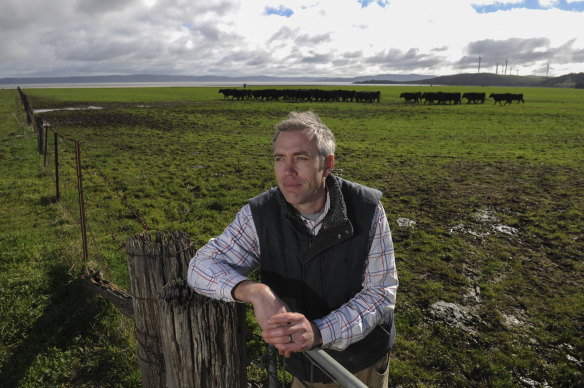
Wind farm developer Luke Osborne thinks locals should be given a stake in renewables projects on their land.Credit: Graham Tidy
When Osborne developed the Coonooer Bridge wind farm near Bendigo, landholders and neighbours were offered shares in the business in 2012. Thirty took up the offer, and in the planning stage the project attracted just one objection. “The money was quite modest,” says Osborne. “It was being given a stake in the project that mattered.” Squadron Energy is offering similar programs to locals at two wind farms in Central-West Orana.
Beyond landholders, Helen Haines wants to create local energy hubs that would act as the voice of communities on how the transition should proceed in their area. The MP was disappointed the Albanese government did not back her proposal in its legislation to establish a Net Zero Economy Authority to manage the transition. Haines understands why the government is backing solar panel manufacturing and other plans for places like the Hunter Valley, but feels it is “missing in action” in rural areas that have never been coal and gas centres.
Perhaps Haines’ plan was rejected because the idea of genuine local voices sounds too radical or impractical. But is there any other way? Government and big business are less trusted than ever. Social media can spread fear, sometimes based on misinformation, that can topple the biggest project. Our sense of community and nation is fractured, and for most people the ties between city and country have long ago been lost. It might be local storytellers who most matter now.
I meet Alison McLean in her Hay Shire Council office after I make the five-hour drive from Dubbo, watching the land grow flat, the soil turn red and trees give way to saltbush. Alongside her day job, McLean runs a sheep farm with her husband, Hugh. They struggled through the Millennium drought, the drought of 2017-20 and the flood of 2022, which for eight weeks made the road out of the farm impassable.
McLean sees all these events as linked to climate change. But that is not her focus when she talks to locals. Instead, she discusses resilience and opportunity. Living far from cities, Hay people are fiercely independent, she says. They know they have to fend for themselves. Perhaps that’s why McLean started telling people: “This transition happens with us, not to us.”
Last year, the council set out to win support for that rallying cry. It convened two public meetings, chaired by Andrew Bray and Kate Hook from RE-Alliance, an organisation that works with regional communities on managing the transition. McLean says the pair answered every question respectfully, while putting a counter view to wilder comments. (One person said climate scientists were agents for a one-world government that was trying to reshape people’s brains.)
Bray told the meetings that the EU and the US might tax imports that did not come from a decarbonised country at some time in the future. “For farmers who rely on exports, that really landed,” McLean says.
The council then sought community feedback to produce a set of principles to guide negotiations with renewables companies. One wish came through strongly: cheaper power for Hay. “If we can see the turbines, we want to feel it in our hip pocket,” says McLean.
Rather than being overrun by companies making competing offers, the council also decided to write a 10-year strategy for the region. It has asked residents to propose “generational change” projects, perhaps in education, health or aged care, that a potential $2 million in annual community benefit funds might support.
In a bold move, the council invited nine developers – including big multinational and Australian companies – to a meeting and asked them to back its 10-year strategy. All agreed. Most offered pledges to reduce power bills. Some offered to make introductions to companies that might set up industries around Hay.
After living in Hay for 25 years – she was born in Orange and spent 20 years in Sydney – McLean, who is 50, feels “a romantic attachment to the plains. To many they’re the most boring landscape in the world, but when I’m standing on them, I feel awe. Nothing stops you seeing nature.” The coming of the turbines won’t change her view. “Some people find them jarring. But our landscapes are always evolving. That’s progress.”
Phil Wilson, the mechanic, is one person who finds the turbines jarring. But “the renewables transition is going to happen whether you are for or against”, he says. “Hay is dying. Just look around. All the shops are shut. We used to have 14 cops, now we’re down to four. We haven’t got housing for the people who want to work here. We need schools and childcare, infrastructure for our future.” But developers must use local contractors like him. “If not, that money is not in Hay.”
Greta Thunberg he isn’t. Yet in this time of hard bargaining, the fight against climate change might depend as much on sceptical mechanics as on superstar Swedish activists. McLean says: “We got Phil involved because he’s smart and he wants the best for Hay. If locals like him don’t back the transition, it won’t succeed.“
McLean has many hopes for Hay. New energy-intensive industries such as almond processing and hydrogen fuel for trucks. Workers’ camps converted to residential aged care once the projects are built. A redeveloped airport that hosts a regular flight or two.
In December, developers for the zone will be chosen, and she’ll know whether these plans have a chance. But perhaps they are already bearing fruit. French company Engie’s proposed Plains Renewable Energy Park near Hay, which might have 188 turbines and nearly a million solar panels, has just gone through planning with not one local objection.
“We’ll never have nightlife, but people might come and go from here with new ideas and visions,” McLean says. “My kids could come home, work not just in agriculture but in a new industry, and have the career of their dreams.” She laughs. “That’s my dream.”
To read more from Good Weekend magazine, visit our page at The Sydney Morning Herald, The Age and Brisbane Times.